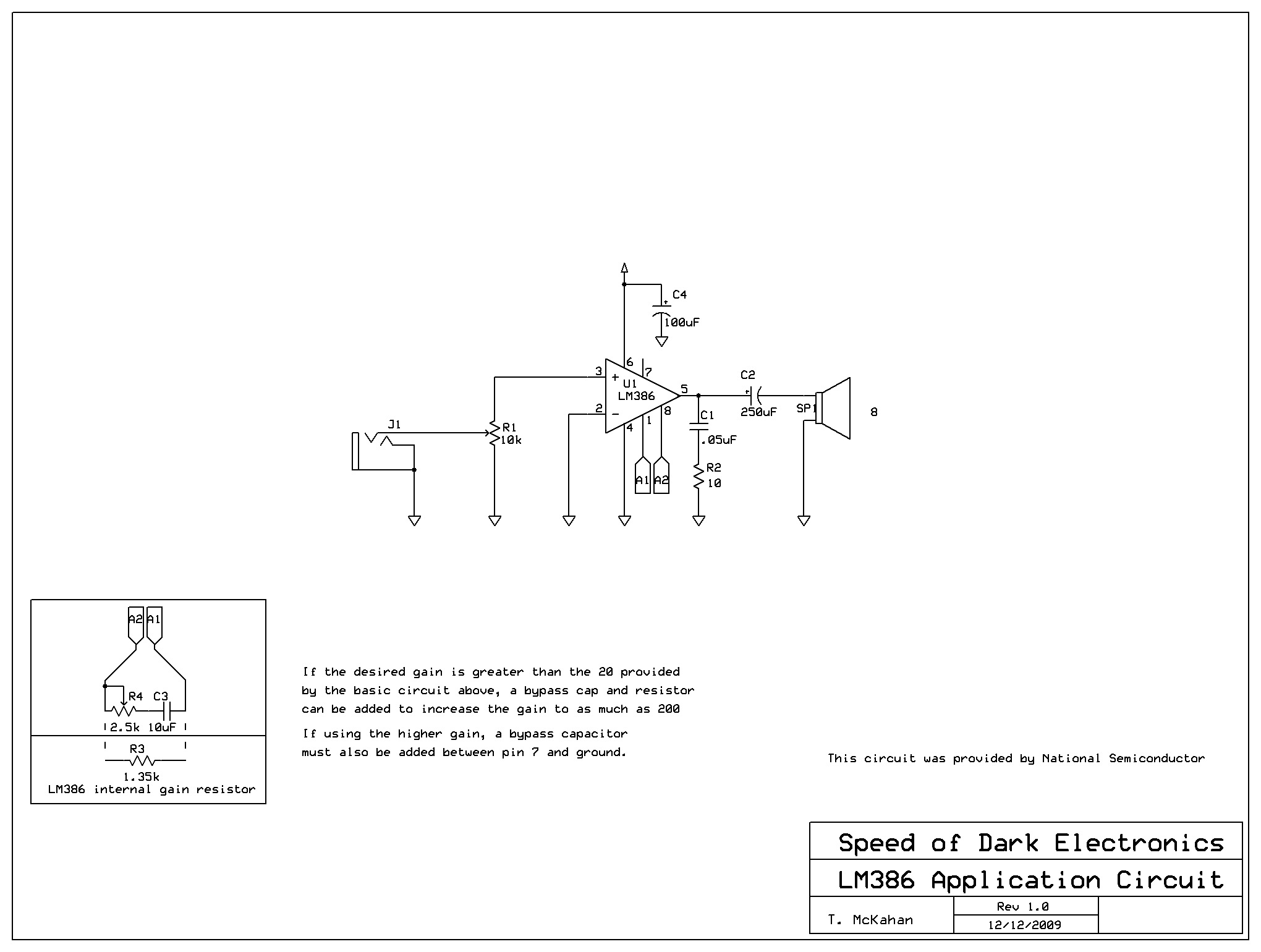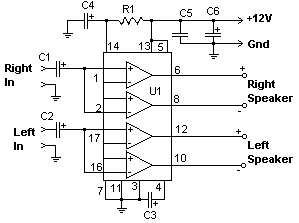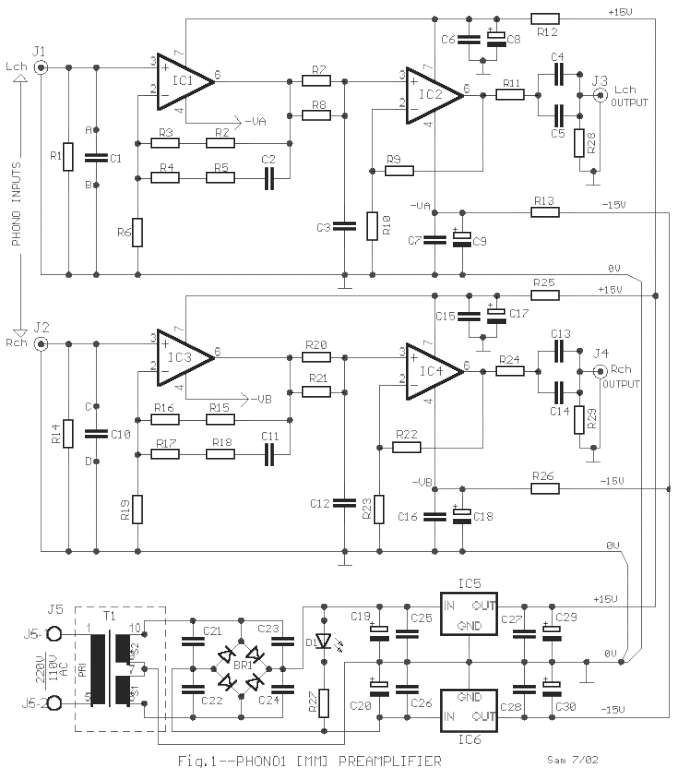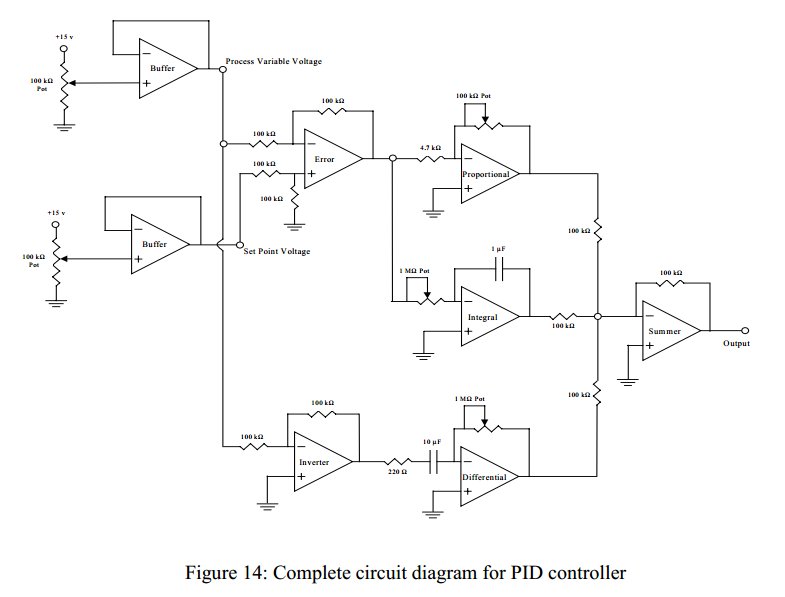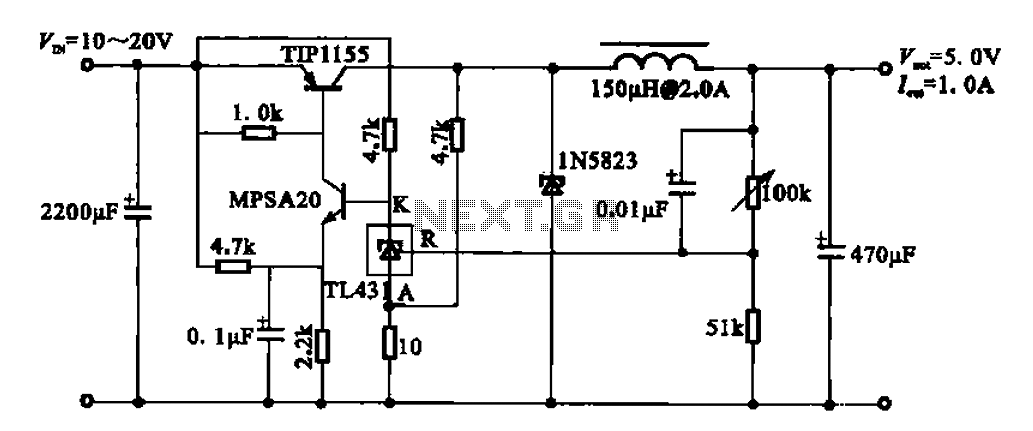
Bridged amplifier circuit diagram of LM4065
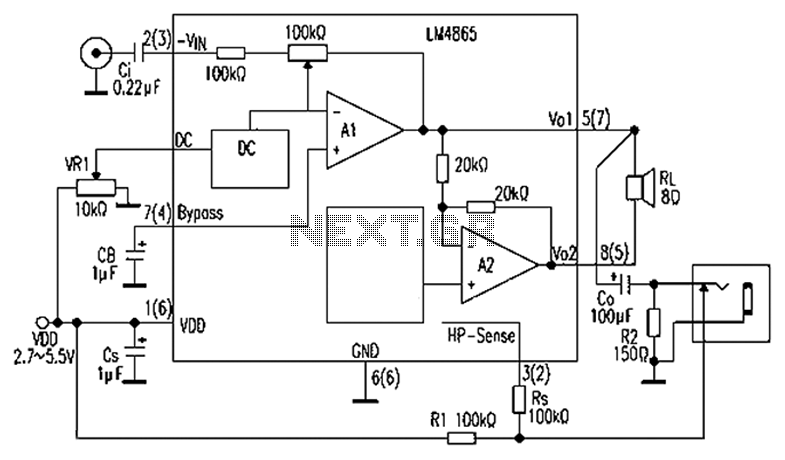
A 750mW bridge-tied load audio amplifier circuit utilizing the LM4065 amplifier is presented below. The LM4865 is available in an 8-pin SO package and an 8-pin mini SMD package. The power supply voltage (VDD) ranges from 2.7V to 5.5V, with a typical quiescent current (IDD) of 4mA. The LM4065 features two amplifiers, A1 and A2, connected to the input and output, producing signals of the same magnitude but with a 180-degree phase difference. This configuration allows the connection of a bridging speaker between the outputs V01 and V02. Compared to a single-ended amplifier, the differential bridge output can deliver four times the output power (P0 = 4VDD²/2 RL) under the same conditions, without requiring coupling capacitors. A capacitor (C0) connects the LM4065's pin to the V01 headset. When the voltage on the HP-Sense pin exceeds a 4V threshold, amplifier A2 is turned off, muting the speaker. In the absence of a headset in the headphone jack, a resistor divider (R1 and R2) sets the voltage on the HP-Sense pin, allowing the LM4065 to operate in bridged mode. Inserting the headphone plug deactivates A2, effectively using the headset as a switch.
The LM4065 audio amplifier circuit is designed for efficient audio amplification in portable devices, providing a compact and powerful solution for audio output. The bridge-tied load configuration enhances the output power significantly compared to traditional single-ended amplifiers, making it suitable for applications where space and power efficiency are critical.
The circuit operates within a power supply range of 2.7V to 5.5V, which allows for compatibility with various battery technologies and voltage levels. The typical quiescent current of 4mA ensures low power consumption when the amplifier is idle, making it ideal for battery-operated devices.
The dual amplifier setup, comprising A1 and A2, is central to the circuit's functionality. The outputs of these amplifiers are designed to be 180 degrees out of phase, which is crucial for driving a bridging speaker. This phase difference enables the circuit to effectively double the output power available to the speaker, achieving greater sound levels without the need for additional components like coupling capacitors, which can introduce distortion and reduce efficiency.
The inclusion of the HP-Sense pin allows for seamless integration with headphone jacks. The resistor divider formed by R1 and R2 ensures that the amplifier operates in bridged mode when no headphones are connected, optimizing the audio output for external speakers. The automatic muting feature, triggered by the insertion of headphones, enhances user experience by preventing unintended audio output through the speaker, thereby preserving battery life and maintaining audio quality.
Overall, the LM4065 bridge-tied load audio amplifier circuit exemplifies modern audio amplification design, combining efficiency, power, and user-friendly features in a compact package suitable for a wide range of applications.750mW bridge-tied load audio amplifier circuit by the LM4065 amplifier with DC volume control IC composition is shown below. LM4865 8-pin SO package and an 8-pin mini SMD packa ge (Figures in brackets SMD package pin number), the power supply voltage VDD 2.7 ~ 5.5V, quiescent current IDD 4mA (typ). LM4065 contains two amplifiers A1 and A2, which is connected to the input output A1 A2, both of which produce the same magnitude but 180 phase difference between the output signal, which can drive connection between the V01 and V02 two outputs bridging speaker.
Compared with the single-ended amplifier, the differential bridge output under the same conditions to produce output power (P0 4VDD2/2 2RL) is four times the single-ended amplifier, and without coupling capacitors. Between the LM4065s pin and V01 headset connected through a capacitor C0. As long as the voltage applied to the IC pin HP-Sense exceeds 4V threshold, the amplifier A2 is turned off, speaker mute.
When the headset is not inserted into the headphone jack, a resistor divider on the HP-Sense pin voltage by R1 and R2 is set to make LM4065 operates in bridged mode load. When the headphone plug into the socket, A2 is turned off. Thus, the headset acts as a switch.
The LM4065 audio amplifier circuit is designed for efficient audio amplification in portable devices, providing a compact and powerful solution for audio output. The bridge-tied load configuration enhances the output power significantly compared to traditional single-ended amplifiers, making it suitable for applications where space and power efficiency are critical.
The circuit operates within a power supply range of 2.7V to 5.5V, which allows for compatibility with various battery technologies and voltage levels. The typical quiescent current of 4mA ensures low power consumption when the amplifier is idle, making it ideal for battery-operated devices.
The dual amplifier setup, comprising A1 and A2, is central to the circuit's functionality. The outputs of these amplifiers are designed to be 180 degrees out of phase, which is crucial for driving a bridging speaker. This phase difference enables the circuit to effectively double the output power available to the speaker, achieving greater sound levels without the need for additional components like coupling capacitors, which can introduce distortion and reduce efficiency.
The inclusion of the HP-Sense pin allows for seamless integration with headphone jacks. The resistor divider formed by R1 and R2 ensures that the amplifier operates in bridged mode when no headphones are connected, optimizing the audio output for external speakers. The automatic muting feature, triggered by the insertion of headphones, enhances user experience by preventing unintended audio output through the speaker, thereby preserving battery life and maintaining audio quality.
Overall, the LM4065 bridge-tied load audio amplifier circuit exemplifies modern audio amplification design, combining efficiency, power, and user-friendly features in a compact package suitable for a wide range of applications.750mW bridge-tied load audio amplifier circuit by the LM4065 amplifier with DC volume control IC composition is shown below. LM4865 8-pin SO package and an 8-pin mini SMD packa ge (Figures in brackets SMD package pin number), the power supply voltage VDD 2.7 ~ 5.5V, quiescent current IDD 4mA (typ). LM4065 contains two amplifiers A1 and A2, which is connected to the input output A1 A2, both of which produce the same magnitude but 180 phase difference between the output signal, which can drive connection between the V01 and V02 two outputs bridging speaker.
Compared with the single-ended amplifier, the differential bridge output under the same conditions to produce output power (P0 4VDD2/2 2RL) is four times the single-ended amplifier, and without coupling capacitors. Between the LM4065s pin and V01 headset connected through a capacitor C0. As long as the voltage applied to the IC pin HP-Sense exceeds 4V threshold, the amplifier A2 is turned off, speaker mute.
When the headset is not inserted into the headphone jack, a resistor divider on the HP-Sense pin voltage by R1 and R2 is set to make LM4065 operates in bridged mode load. When the headphone plug into the socket, A2 is turned off. Thus, the headset acts as a switch.
